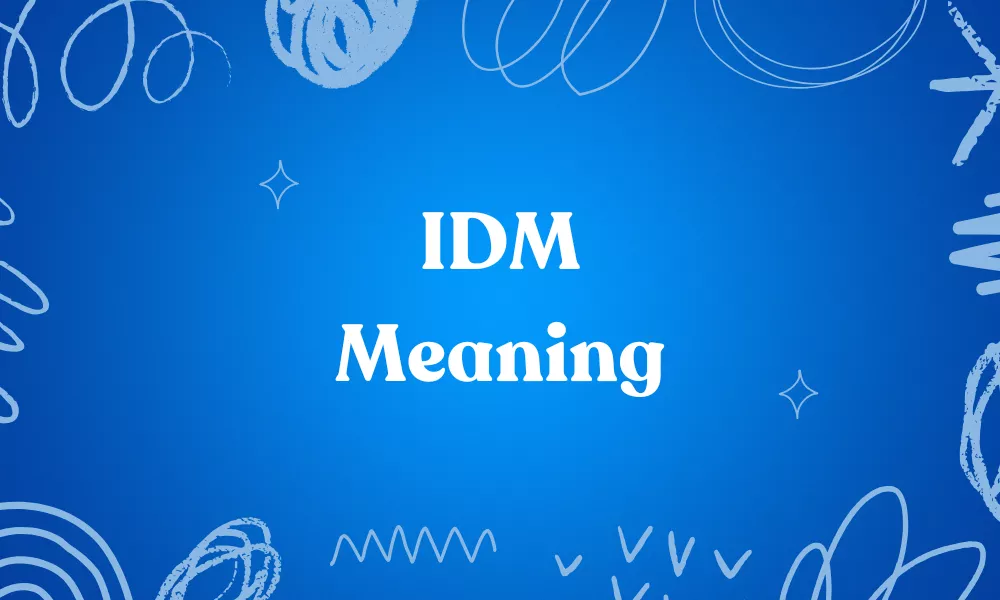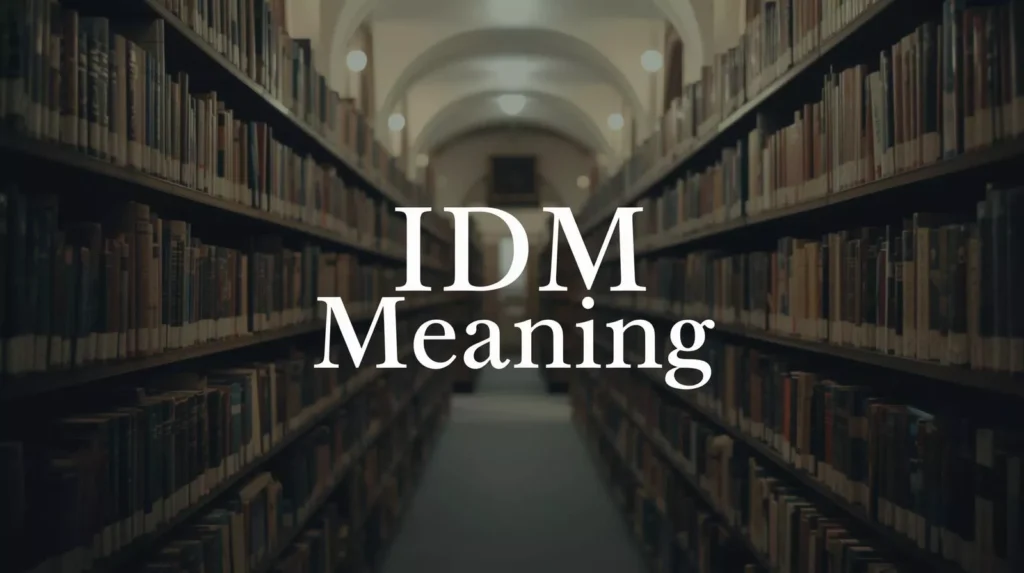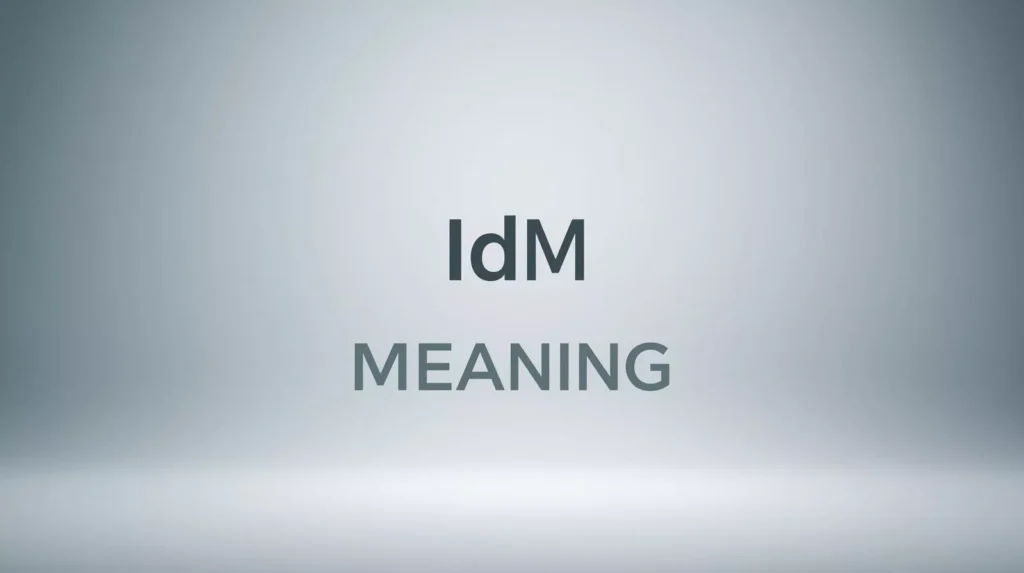IDM Meaning – What Does IDM Stand For in Text and Chat?

Ever gotten a message that just says “IDM” and wondered what it means? You’re not alone. In today’s fast-paced digital world, abbreviations and internet slang dominate our chats, from Instagram DMs to WhatsApp groups. One popular but often confusing term is “IDM.” Depending on the context, IDM can mean “I Don’t Mind,” a casual way to show agreement or indifference in conversation. However, it can also have other meanings in music or technology, such as “Intelligent Dance Music” or “Internet Download Manager.” .
What Does “IDM” Mean?
“IDM” most commonly stands for “I Don’t Mind.” It’s a casual way of expressing openness, agreement, or indifference in conversation. When someone says IDM, they’re usually indicating that they’re fine with any option or suggestion. For example, if a friend asks where to eat and you reply “IDM,” you’re basically saying, I’m okay with anything.
What Does “IDM” Mean on Snapchat and Other Platforms?
On social apps like Snapchat, Instagram, WhatsApp, and TikTok, “IDM” carries the same general meaning “I Don’t Mind.” It’s often used in response to casual questions, invitations, or plans. For instance, someone might message “Want to call later?” and you could reply “Sure, IDM.” Because of its friendly and laid-back tone, it’s widely used in both personal and group chats across platforms.

Origin of “IDM” in Texting Slang
The abbreviation “IDM” originated from early internet chatrooms and text messaging culture where users shortened phrases to save time. As texting and instant messaging grew popular in the 2000s, people began using quick acronyms like “IDC” (I Don’t Care) and “IDM” (I Don’t Mind) to speed up responses. Over time, IDM became a standard part of online slang used globally.
Psychology Behind “IDM”
Saying “IDM” reflects a person’s easygoing and agreeable attitude. It shows emotional flexibility and a willingness to go along with others’ choices, which can help maintain harmony in casual or social interactions. Psychologically, using “IDM” signals low conflict and a cooperative mindset, traits often valued in friendly, digital communication.
How to Use “IDM” in Conversations
You can use “IDM” when you want to show flexibility or agree with someone’s idea without having a strong opinion. It’s often used to keep conversations light and cooperative. For example, if someone says, “Let’s watch a movie tonight,” replying with “Sure, IDM” means you’re fine with the plan either way.
When Can You Send “IDM”?
Send “IDM” in casual situations where you’re comfortable with any option. It’s perfect for friendly chats, group decisions, or informal online discussions. However, it’s best to avoid using it in professional or serious contexts, where more precise communication is expected.
Examples of “IDM” in Real Texts
- Friend 1: Wanna grab coffee or bubble tea?
Friend 2: IDM, you choose! - Partner: Should we go out or stay in tonight?
You: IDM, I’m good either way. - Group Chat: Meeting at 5 or 6?
You: IDM, whatever works best for everyone.
Read: EYP Meaning
How to Reply When Someone Sends “IDM”
When someone replies with “IDM,” it means they’re leaving the decision up to you. You can take the lead by confirming a choice or asking for clarification. For example, reply with “Okay, let’s go with 6 then!” or “Alright, I’ll decide.” This keeps the conversation flowing smoothly.
Tone of “IDM”
The tone of “IDM” is friendly, easygoing, and neutral. It doesn’t show excitement or negativity, it simply expresses agreement or indifference. Depending on context, it can feel polite and flexible, but overusing it might make you seem uninterested or passive.
Common Mistakes When Using “IDM”
A common mistake is using “IDM” in formal settings, like emails or work chats, where it might sound too casual. Another error is misunderstanding it as rude or dismissive; it usually isn’t! Also, avoid using “IDM” when a clear decision is needed, as it can come across as indecisive.
Alternative Meanings of “IDM”
| Context | Full Form | Description |
|---|---|---|
| Texting | I Don’t Mind | Expresses flexibility or lack of preference |
| Music | Intelligent Dance Music | A genre of experimental electronic music |
| Software | Internet Download Manager | A program that accelerates file downloads |
| IT Security | Identity Management | Systems controlling user access and authentication |
Why People Use “IDM”
People use “IDM” (I Don’t Mind) because it’s a quick, friendly way to show they’re open to suggestions or flexible about a decision. It helps keep conversations smooth and avoids unnecessary back-and-forth. In casual chats, “IDM” conveys an easygoing attitude, making it ideal for friendly discussions, group plans, or online interactions.
IDM vs. Similar Slang Acronyms
While “IDM” means I Don’t Mind, other acronyms like “IDC” (I Don’t Care) and “IKR” (I Know, Right) carry different tones. IDC sounds more dismissive, while IDM feels cooperative and polite. Understanding these subtle differences helps you communicate the right mood whether it’s positive, neutral, or indifferent, without causing misunderstandings.
Read: FFS Meaning
Advanced IDM Usage Across Platforms
As online communication evolved, “IDM” adapted to various digital spaces, from texting apps to social media. Advanced users often use it to express agreement, neutrality, or to keep group chats inclusive. Its meaning stays consistent, but its tone can shift depending on the platform and context like casual on Snapchat, polite on WhatsApp, or chill in gaming servers.
On WhatsApp and Messenger
On WhatsApp or Messenger, “IDM” is a casual reply showing you’re fine with any plan. It’s often used among friends or family to simplify decisions, like picking meeting times or food options. For example: “Lunch at 2?” → “IDM.” It keeps chats short, friendly, and flexible.
On Instagram and Snapchat
On Instagram and Snapchat, “IDM” is often seen in DMs and comment replies. It’s a quick way to show indifference in a lighthearted way for example, when reacting to stories or casual invites. Since these platforms are more visual and informal, “IDM” adds a relaxed, easygoing tone to conversations.

In Gaming Chats and Discord Servers
In gaming chats and Discord servers, players use “IDM” to express neutrality in group decisions like map choices, roles, or game modes. It helps maintain team harmony and quick coordination without sounding uninterested. Example: “Which map?” → “IDM, pick anything.” Among gamers, it signals cooperation and adaptability.
Alternatives to “IDM”
Casual Alternatives
In friendly or relaxed chats, you can replace “IDM” with informal expressions like:- “Sure thing”
- “I’m cool with that”
- “Whatever works”
- “Up to you”
Polite Alternatives
When you want to sound respectful or considerate, try more courteous options such as:- “I’m fine with either”
- “I don’t have a preference”
- “Either is okay for me”
Professional Alternatives
In formal settings like work emails or business chats, it’s best to use clear and polite phrases instead of slang. Try saying:- “I’m open to any option.”
- “I’m comfortable with your decision.”
- “Either choice works for me.”
Read: OML Meaning
FAQs
Conclusion
In today’s digital world, abbreviations like “IDM” (I Don’t Mind) make conversations faster, friendlier, and more expressive. Whether you’re chatting on Snapchat, WhatsApp, or Instagram, “IDM” helps you show flexibility and agreement without overexplaining. It’s a small acronym with a big impact which is perfect for casual conversations, gaming chats, and even light professional talk when used correctly. Now that you know the meaning, tone, and usage of IDM, you can text confidently and keep your digital communication smooth and natural.
